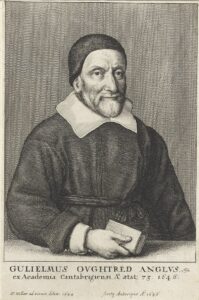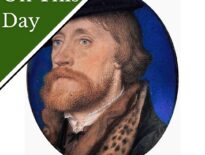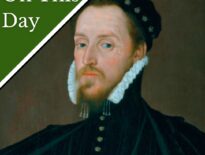 On this day in Tudor history, 5th March 1575, in the reign of Queen Elizabeth I, mathematician William Oughtred was baptised at Eton College, where his father, Benjamin, was registrar and writing master.
On this day in Tudor history, 5th March 1575, in the reign of Queen Elizabeth I, mathematician William Oughtred was baptised at Eton College, where his father, Benjamin, was registrar and writing master.
Oughtred is responsible for developing a straight slide-rule, a gauging rod and various sundials. He also introduced the "×" symbol for multiplication and the abbreviations "sin" and "cos" for the sine and cosine functions.
Let me tell you a bit more about him…
- Oughtred was educated at Eton, as a king’s scholar, before moving to King’s College, Cambridge in 1592. He attained his BA in 1596 and his MA in 1600.
- As well as a mathematician, Oughtred was a clergyman, being ordained in 1603. He became vicar of Shalford, in Surrey, in 1605, and in 1610, he became rector of Albury, serving in that position until his death in 1660.
- In February 1606, Oughtred married Christsgift Caryll in her home parish of Tangley in Surrey. The couple went on to have 12 or 13 children, the records differ
- As well as his church work, Oughtred tutored maths locally, and in 1628 was employed in the household of Thomas Howard, 2nd Earl of Arundel, and taught his second surviving son, William, compiling a mathematical textbook for him in 1631. It’s Latin title is rather long, but it’s commonly known as his Clavis or Clavis Mathematicae. It was used by many mathematicians, scholars and teachers as a teaching text.
- While working in Thomas Howard’s household in London, Oughtred came to know other mathematicians in the city, along with instrument makers, such as Elias Allen, who made instruments according to Oughtred’s designs, such as “the circles of proportion”, a slide rule, which, according to historian Frances Willmoth, “allowed problems of multiplication and division to be reduced to addition and subtraction by the use of logarithms”. He published an account of this device, “The Circles of Proportion and the Horizontal Instrument … Invented, and the Uses of Both Written in Latin”. The horizontal instrument in the title referred to an instrument on the back of the circles of proportion, which Willmoth describes as “a tool for demonstrating astronomical principles and for laying out sundials on any kind of plane”. In 1636, in his “The Description and Use of the Double Horizontall Dyall”, Oughtred adapted the horizontal instrument to make a garden sundial.
- Oughtred fell out with a former pupil, Richard Delamain after Delamain published on the slide rule and horizontal instrument, claiming he’d invented them. Oughtred went as far as publishing an attack on Delamain “The Circles of Proportion: To the English gentrie … the just apologie of Wil: Oughtred, against the slaunderous insimulations of Richard Delamain”.
- Oughtred’s other inventions included another sundial, and probably the universal equinoctial ring dial, a gauging rod and a straight slide rule.
- His other written works include the 1651 “The Solution of all Sphaerical Triangles”, the 1657 “Trigonometria” and a collection of treatises published after his death as “Opuscula mathematica”.
- As well as mathematics, Oughtred was interested in astronomy, astrology and alchemy.
- Oughtred died on 13th June 1660 and was buried at Old St Peter and St Paul's Church in Albury on 15th His estate was granted to his son, Henry, the following year.
- Oughtred’s daughter, Elizabeth, married Christopher Brookes, who edited her father’s 1651 work “The Solution of all Sphaerical Triangles”, while two of his sons became watchmakers.
- Trivia: The American Oughred Society, which was founded in 1991 and which describes itself as “a group of slide rule collectors” “dedicated to the preservation and history of slide rules and other calculating instruments”, takes its name from William Oughtred. Here's you a link to their website - http://www.oughtred.org/
Also on this day in Tudor history...



How do you pronounce William Oughtred’s surname? I can’t find the pronunciation anywhere, not even (so far) on the website of the Oughtred Society. Hoping you can help!
I think it’s “aw-tred”, with the “tred” being quite short, almost “trid”.